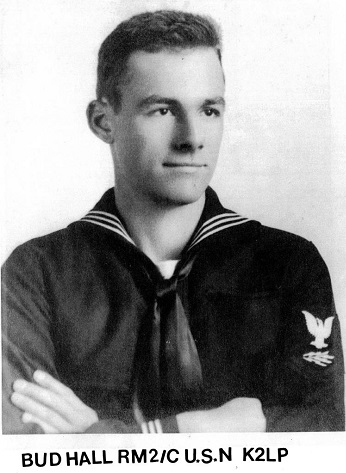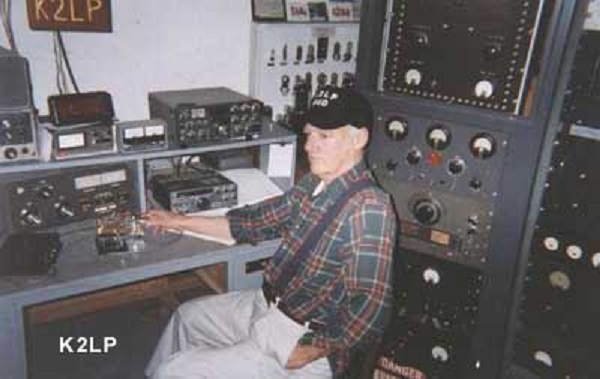 |
Marvin D. 'Bud' Hall Eastman, MA QCWA # 04351 |
From AWA: Bub Hall, K2LP in his USN uniform
M.D. "BUD" HALL JR BORN 8/02/21 LICENSED W2LSX 1938 CRANFORD ,N.J. HIGH SCHOOL '39 R.C.A. INSTITUTE '40 MELVILLE AERONAUTICAL INSTITUTE ,N.Y. COMMERCIAL TELEGRAPH AND PHONE TICKET 1941 FLIGHT CONTROL COMMUNICATIONS AMERICAN AIRLINES '41-'43 U.S. NAVY '43 -'46 RADIOMAN 2ND CLASS SET UP COMMUNICATIONS STATION IN WAKAYAMA ,JAPAN SERVED ABOARD USS CASCADE AD-16 AND LST 681 RETIRED FROM MORRIS COUNTY COLLEGE 1982 MOVED TO CAPE COD 1983
Notes from Bud Hall, K2LP (Formerly W2LSX) as transcribed by Doug Crompton, WA3DSP, 2/24/2012
I spoke with Bud on the phone today for at least an hour and a half in which he related much of his post high school technical life.
Bud related that he was not a good student in high school, he went after the girls and played sports rather than hitting the books. His father was naturally interested in his future and with the monetary aid of an aunt he enrolled in the RCA institute in 1939. Shortly after starting his classes there he realized that some of the math was well above his ability. The school also realized this and offered him an alternative course in Aeronautical Communications. The teacher was Frank Melville, W2AQK, but a short time later Frank decided he no longer wanted to teach at the institute. Mel and another student who wanted to take this course were dismayed. They asked Frank before he left if he would agree to tutor them outside of the institute. He agreed and invited them to his home an 1870 Victorian in Flushing, NY. Upon arriving Frank sent Bud and his fellow student out to get materials to build two operating benches. The benches would hold a mill (typewriter) and a key. They built the benches and proceeded to spend many hours each day taking turns sending and receiving code messages at their operating positions.
Bud rented a room at the home from Frank's mother. Before long several more students arrived and the teacher along with several students went to New York City to apply for a teaching license to make the school official. The license was granted and the school became the Melville Aeronautical School.
After attending the school Bud landed a job with American Airlines at LaGuardia Field. He used a 1939 Chevy to get back and forth to work. He stayed with this job 1942, learning the communications protocol and increasing his code proficiency. In 1942 American Airlines sent him to Big Spring, Texas, a town with just cows and cowboys. It took almost a week to get there with layovers and delays as military cargo and personnel had priority. The airport in Big Spring was an adobe structure with three rooms. This was quite a life change for Bud, a Yankee city boy! Bud married his girlfriend while there and he and (WIFES NAME) later went on to Fort Worth.
By 1944 the war was at its peak and Bud decided to join the Navy. Due to his communications background he was trained in setting up advance radio sites. One of the systems was the BC610, BC348, generator and other necessary equipment housed on a trailer. By the time he headed out to the Pacific VJ day had arrived. He went through Hawaii, then on a slow LST to Okinawa where he met up with some high school buddies, and finally to Japan to set up communications sites in areas devastated by the war. One areas that they worked in was the Kobe Bay where massive mine sweeping was going on.
After his tour of duty in the Navy Bud was discharged at Long Island New York. Shortly after his discharge Bud started receiving telegrams from American Airlines in New York. He went for an interview and found out that they wanted to send him to Tulsa. Bud refused the job because he wanted to stay home with his wife and budding family.
American Airlines had also changed much of its communications from CW to teletype and there was less need for skilled operators.
Bud took a job with Cornell Dubilier for a short time then went to work in Newark, New Jersey at RADISCO, The RCA distribution Company. He worked on amplification systems for the race track.
Later Bud heard there was a job at the Newark airport. It was a small airline that hauled lobsters from Maine to New Jersey in DC3's. The radios were BC-310's with 211A's and the radio room was small and poorly outfitted.
Bud then went on to work for Trans Caribbean Airlines, a very small airline with one airplane at Newark. They were later bought out by American Airlines.
In about 1950 Bud's wife must have known that he was not happy at his job and she saw an employment ad in local newspaper. Bud applied for the job and got it. The company was Kellog in Jersey City. They made rocket assisted launchers for the Air Force. Bud built a console that was used to trigger the rockets. The company closed on January 1, 1953.
Bud was out of a job and had no interviews in site. Then in March of 1953 at a Somerset Hills, New Jersey radio club meeting Bud was introduced to a man who wanted to interview him. He was hired and went to work for the Vetro Corporation in West Orange, New Jersey. They had contract with the Atomic Energy Commission. Bud assisted in building a rack that was 20 feet long and 7 feet high and had equipment to time the trajectory of rockets. It was a vacuum tube design and generated a video signal that was superimposed on each frame of a film. Vetro sent bud to Rome AFB in 1957 to evaluate the jamming of radar signals. They built a lab in West Orange, New Jesrsey which consisted of all types of radar to assist in the evaluations. They used air traffic in the Newark to setup the radar.
One story that Bud related that show how times have changed. While at the West Orange one of the lab personnel passed out. They later found out it was due to leaking nerve gas that was being produced nearby.
Bud's boss at this point Frank, W9LRX, came to him with a very special project. He wanted Bud to build a high power oscillator. The reason was a secret. Bud proceeded to gather the materials needed, 4TL vacuum tubes, a Butterfly capacitor, tank coil, etc. The oscillator operated on 27 Megacycles. After it was completed it was taken to the Physics Department. On the day of the test Bud was present and he noticed that the tank coil which consisted of 5 or 6 turns of copper tubing was mounted outside of the rack and within the tank was mounted a stainless steel nozzle. There was also a spectra photometer nearby. When the test started there was a tremendous blast and noise. The spark was over 8 inches long from the nozzle.
Bud later found out that this was the first test of an RF plasma generator and it was a prototype that would later be used to test the tiles used to protect the capsules in the developing space program in the late 1950's. One of the physicists, N1PE, later sent Bud the photographs of the unit he had built.
